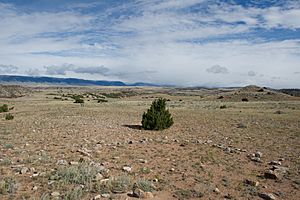Tipi ring facts for kids

Tipi rings are circles of stones left behind by Native American people long ago. These stone circles show where their homes, called tipis, used to stand. You can find them mostly across the Great Plains in the United States and Canada, and also in the foothills of the Rocky Mountains.
These stone circles are often found in good camping spots. These spots were usually close to water, wood for fires, and places where people could hunt. Sometimes, these groups of stone circles are arranged in cool patterns, like rows, big circles, or even V-shapes! The stones were used to hold down the bottom edges of the tipis. This helped keep the homes warm and dry, especially when the wind blew.
Contents
What Are Tipi Rings?
Tipi rings are usually about 6 to 25 feet (1.8 to 7.6 meters) wide. They often appear in groups. The stones held down the animal skin covers of the cone-shaped tipis. This kept the tipi snug against the ground.
A typical tipi ring often has an opening on the east side, where there are no stones. The side facing the wind, usually the northwest, has extra stones. This made the tipi stronger against strong winds. If a hearth (a fireplace) is found in the middle of a tipi ring, it suggests the camp was used in winter. In summer, people often cooked outside. Not many artifacts (old tools or items) are usually found at these sites.
Different Kinds of Stone Circles
Tipi rings are one type of stone circle. Some stone circles are just simple rocks placed in a single or double layer. More complex circles might have been built with stone walls, or with logs and stones. These might have been used as forts or corrals for animals.
Other stone circles are much larger, some more than 39 feet (12 meters) across! These might be the remains of special dance areas or ceremonies. A few stone arrangements even look like human figures, mostly men. The most interesting stone patterns are called medicine wheels. Most stone circles you find are tipi rings, unless they are medicine wheels or very small.
After people from Europe arrived, Native Americans started using wooden pegs instead of stones to hold down their tents. This was because they now had axes to cut wood. In the Crow language, the word for "precolonial times" (before Europeans settled) literally means "when we used stones to weigh down our lodges."
Studying Tipi Rings
Scientists have studied many tipi rings. For example, a study on the Blackfeet Indian Reservation looked at 137 sites. They found that tipis were often set up in patterns. These patterns included single or double rows, semi-circles, circles, triangles, V-shapes, or sometimes just random shapes.
The only artifacts found at these sites were stone or bone tools. These included broken projectile points (like arrowheads), hammerstones, and pieces of flint or obsidian. After horses were brought to America around 1730, people could move larger tipis. Horses could pull camp materials instead of dogs. This meant tipis became much bigger, able to hold 6-8 people, and sometimes even up to 50 people!
Where to Find Tipi Rings
You can find tipi rings in many places across North America.
In Canada
- Alberta: In 1989, over 4,290 tipi rings were recorded in Alberta!
- Carmangay Tipi Ring Site
- Nose Hill Park
- Suffield Tipi Rings National Historical Site
- Writing-on-Stone Provincial Park
- Saskatchewan:
In the United States
There are 136 tipi ring sites in a 300-mile (480 km) area between Green River, Wyoming and Denver, Colorado.
- Colorado:
* In the mountains, the Ute people made tipi rings. On the plains, the Apache, Arapaho, Cheyenne, and Comanche people made them. * Northern mountains and foothills: ** Indian Mountain near Boulder ** T-W Diamond site near Fort Collins * Northeastern plains: ** Biscuit Hill Site (with 78 to 100 tipi rings!) ** Keota Stone Circles Archaeological District * Southeastern plains: ** Carrizo Ranches (possibly Apache sites) ** Picture Canyon of the Comanche National Grassland
- Montana:
** Blackfeet Indian Reservation has 210 tipi ring sites. ** Canyon Ferry Reservoir area has 16 tipi ring sites. ** First Peoples Buffalo Jump State Park
- Texas:
** Squawteat Peak in Pecos County
- Wyoming:

